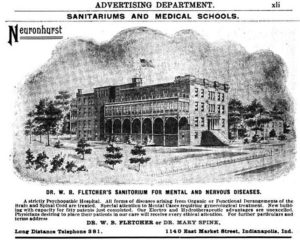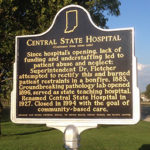Theodore Clement Steele, American, 1847–1926
1909
Oil on canvas
106.68 cm x 86.36 cm | 42 in x 34 in
Framed: 137.16 cm x 116.84 cm |54 in x 46 in
Courtesy of Indiana Medical History Museum, Indianapolis, Indiana
William B. Fletcher, M.D.
August 18, 1837 – April 25, 1907
Dr. Fletcher was an advocate for public and mental health reforms and renowned for abolishing the use of physical restraints at the Indiana Hospital for the Insane in Indianapolis in 1883 of which he was superintendent. This institution later became Central State Hospital and today visitors can tour the oldest Pathology Building in the nation known at The Indiana Medical History Museum located on the former hospital grounds.
Dr. Fletcher’s approach toward “moral treatment” for mentally ill patients was demonstrated by his burning of more than 500 straight jackets, covered cribs, restraint chairs, and similar devices in bonfires. He influenced generations of future physicians as a professor of medicine in Indianapolis. He also employed women teachers and staff during his tenure, and hired Dr. Sarah Stockton as an assistant physician in the women’s department. Dr. Stockton was the first female to hold that position.
 In 1888, Dr. Fletcher established a Sanatorium, known as Fletcher’s Sanatorium and then Neurohurst (after 1904) which was one of Indianapolis’s first private hospitals for the treatment of nervous and mental diseases in Indiana.
In 1888, Dr. Fletcher established a Sanatorium, known as Fletcher’s Sanatorium and then Neurohurst (after 1904) which was one of Indianapolis’s first private hospitals for the treatment of nervous and mental diseases in Indiana.
Dr. Fletcher studied at Indiana Asbury University (now DePauw University) and then attended the College of Physicians and Surgeons in New York City, earning his medical degree in 1859.
He also served in the Civil War in the Union Army. He was taken prisoner near Big Springs, VA while engaged on a scouting expedition and was sentenced to be shot, but was reprieved by General Lee and send to Libby Prison (Richmond, Virginia) where he was placed in charge of a hospital.1
 Dr. Fletcher was born in Indianapolis and was the son of prominent Indianapolis banker, attorney, farmer and state senator Calvin Fletcher and his wife Sarah Hill Fletcher. Fletcher Place, a historic neighborhood in Indianapolis, is named after his father Calvin Fletcher and recognized for the elder Fletcher’s legacy in helping shape Indianapolis in the early to mid-1800’s. Calvin and Sarah Fletcher had eleven children, two daughters and nine sons. The diary of his father, Calvin Fletcher is covered in a nine volume collection published by the Indiana Historical Society. Dr. Fletcher was called “Billy” by his father Calvin Fletcher.
Dr. Fletcher was born in Indianapolis and was the son of prominent Indianapolis banker, attorney, farmer and state senator Calvin Fletcher and his wife Sarah Hill Fletcher. Fletcher Place, a historic neighborhood in Indianapolis, is named after his father Calvin Fletcher and recognized for the elder Fletcher’s legacy in helping shape Indianapolis in the early to mid-1800’s. Calvin and Sarah Fletcher had eleven children, two daughters and nine sons. The diary of his father, Calvin Fletcher is covered in a nine volume collection published by the Indiana Historical Society. Dr. Fletcher was called “Billy” by his father Calvin Fletcher.
Dr. William B. Fletcher died in 1907 at his second home in Orlando, Florida. His death was widely covered in both press and medical journals here and abroad. Hoosier poet, James Whitcomb Riley, memorialized Fletcher in his poem “The Doctor”, with a repeating line “Why not idealize the doctor some?”2
Dr. Fletcher is buried in Crown Hill Cemetery in Indianapolis. James Whitcomb Riley served as an honorary pallbearer.3
1St Louis Medical Review, obituary, June 1, 1907, pg. 557
2“Indiana’s 200: The People Who Shaped The Hoosier State”, Gugin, Linda C., and St. Clair, James E., Indiana Historical Society Press, Indianapolis, May 2016, ISBN-13: 9780871953933
3The Indianapolis Star, Indianapolis, Indiana, 30 April 1907, page 3.
4Brigham, Loriman S., ed. “The Civil War Journals of William B. Fletcher.” Indiana Magazine of History 57 (March 1961): 43-76.
5Drenovsky, Rachael L. “Humanity’s Bonfire: William B. Fletcher, M.D.: 1837-1907.” Traces of Indiana and Midwestern History 13, no. 2 (Soring 2001): 19-25.



